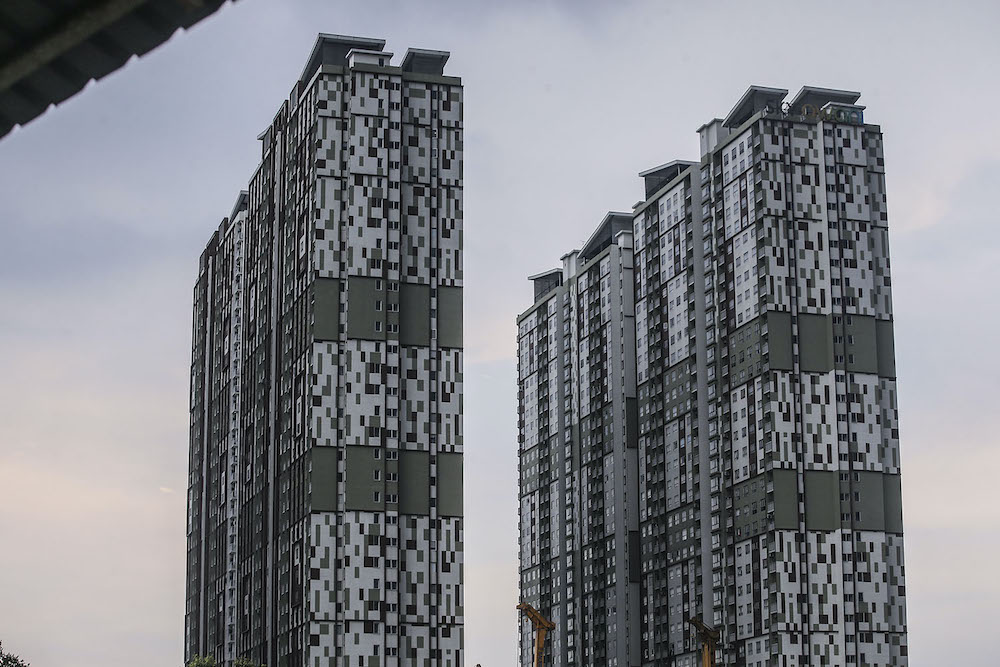KUALA LUMPUR, Jan 26 — Property overhang spurred by unaffordability continues to remain a persistent issue in the real estate industry notwithstanding the Covid-19 pandemic, property consultant Rahim & Co International said today.
Rahim & Co director of research Sulaiman Akhmady Mohd Saheh said there were 57,390 units (residential, serviced apartment & SoHo units) worth RM42.49 billion as of the third quarter of 2020 (3Q2020), adding that property overhang remains a serious concern within the market.
He said the issue was related to unaffordability of home buyers where residential units such as terraced houses remained severely out of reach to those dwelling in Kuala Lumpur and other major urban areas in the country.
“Overhang numbers also grew by 14.8 per cent to 57,390 units worth RM42.49 billion of dwelling units.
“Improvement was observed for unsold units under the category of ‘under construction’ and ‘not yet constructed’ whereas ‘completed/overhang’ units persistently grew.
“While this may be due to the pandemic's effect, the persisting overhang numbers are evidence of a problem that is yet to be tackled effectively and it will continue to remain so,” he said during a virtual briefing of the company’s annual publication entitled Property Market Review 2020/2021 here.
Sulaiman added that overhang stock comprised more non-landed units than landed units, with Johor, Selangor and Wilayah Persekutuan Kuala Lumpur remaining the top states with the highest number of overhang units.
Rahim & Co chief executive Siva Shanker also echoed Sulaiman’s remark, adding that the availability of vaccines amid the Covid-19 pandemic would in fact do more in improving buyers’ sentiment this year which will be carried forward to 2022.
“We can expect the residential market to recover slightly and move upwards on the back of vaccination and renewed sentiment,” he said.
According to the report, a total of 192,956 overhang units were recorded including 113,576 unsold units currently under construction and 21,990 unsold units not under construction.
Johor and Selangor accounted for the highest number of overhang units at 23,072 and 8,791 respectively, followed by Kuala Lumpur at 7,863 units as of 3Q2020.
Asked whether the reintroduction of the Home Ownership Campaign (HOC) by the federal government in 2020 had helped improve in mitigating overhang issues, Sulaiman said the initiative did little to alleviate the problem and the numbers are unlikely to significantly drop in 2021.
When compared with the first nine months of 2019, the residential sector recorded a decrease of 14.3 per cent in transaction volume while both office and retail sectors similarly saw reductions of 1.4 per cent and 2.0 per cent respectively in the same period last year.
As the largest segment of Malaysia’s property market, the residential sector saw a decline in the
first nine months of 2020 by 14.3 per cent in volume and 14.8 per cent in value in spite of a better year-on-year performance in the third quarter when the country entered the recovery MCO phase.
For the commercial sector, the report said office and retail markets remained challenging as effective occupancy rates were depressed during the MCO period for several factors when Work-from-Home policy became a new norm and E-Commerce trends moulding new directions in consumer behaviour.
“Rentals and occupancy rates are under pressure, influenced primarily by relocation activities rather than brand new tenancies,” Sulaiman said.
According to the review, the Malaysian retail occupancy rate averaged 83.2 per cent in 3Q2019 but as at 3Q2020, this had dropped to 80.4 per cent, while vacant space has increased from 12.13 million square feet to 14.46 million square feet in the same period.
“The need for physical interactions, necessary space separation and credible business addresses remain relevant for most businesses but are now expected in smaller portions and customisable tenancy arrangements.
“Notwithstanding these trends, the office sector is still facing an oversupply situation with occupancy rates steadily dropping. This puts building owners under pressure to retain their rental yields.
“Acknowledging a similar concern in the retail sector, the company highlighted that retail malls
faced the challenge of volatile foot traffic and temporary closure periods on top of a rising vacancy that put the sector under further pressure,” the report added.
Last but not least, the report said the logistics sector continues to drive demand for industrial properties boosted by the overwhelming demand for e-commerce transactions which will continue to hold the spotlight moving forward.
“Considering the slower relative pace of incoming supply, especially for managed industrial parks with built-to-suit arrangements, industrial property investments are to be keenly observed this year,” it said.



















